
18 Hour Old Crescent Moon,
IC342 Galaxy, NGC2359 Thor's Helmet
Posted: 11 February 2013
As I mentioned on my last report, it snowed Saturday morning, 9 February 2013. My live webcam with a view towards the observatory captured the snow and its melting during the day. I have posted a time-lapse video from the webcam. The sky was forecast to start clearing in the afternoon, but snow and occasional ice pellets kept falling. Even though the prospects didn't look good, as there was to be an excellent ISS pass that night, late in the afternoon I went to the observatory to clean remaining snow off the dome. You can see me in the video beginning at 4:03:58 PM MST. Unfortunately, the sky didn't clear up.
Sunday, 10 February, was mostly clear. The observatory was opened at 1747 MST, 57°F. I wanted to try for the very young crescent moon at 1820 MST (15 minutes after sunset), when it would be exactly 18 hours old. That would be a new record observation for me. My previous record was on 27 May 2006, when I observed a 21 hour 18 minute old moon. My observation, with photos, is on my "Oracle Observatory" report from that date.
This evening, there were no clouds that would interfere with observing the moon, if it would be visible. At 1800 MST, I began (carefully, since the sun was still above the horizon) scanning the western sky for the thin crescent moon using 7x50 binoculars. No luck at seeing the moon. At 1805 MST, the sun set. At 1807 MST, I slewed the 8" telescope to Mercury to check the focus and then slewed to the moon's position. No moon was visible in the finderscope. I resuming scanning the sky again with the 7x50 binoculars, using the direction the telescope was pointing as a guide. At 1811 MST, I could faintly see the crescent moon with the binoculars. It was also visible at 77X in the telescope. This is a new record for me! A new moon, only 17 hours and 51 minutes old. Nice!!!
I mounted the iPhone 4 on the telescope with the MX-1 adapter using a different eyepiece for afocal 77X imaging. Unfortunately, the focus position changed and the moon was too faint and thin to see to focus the eyepiece. I quickly slewed to Mercury to refocus and then returned to the moon. This image of the moon was captured at 181648 MST, showing a 17 hour 57 minute moon:
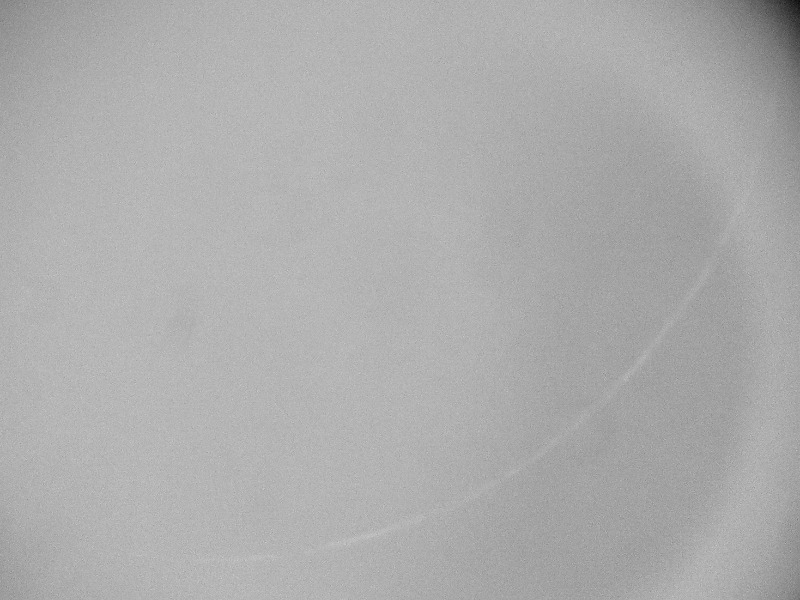
At 1820 MST, when the moon was precisely 18 hours old, I used the 7x50 binoculars to view it. It remained a difficult object to see in the still bright western sky. At 182327 MST, I captured this image:
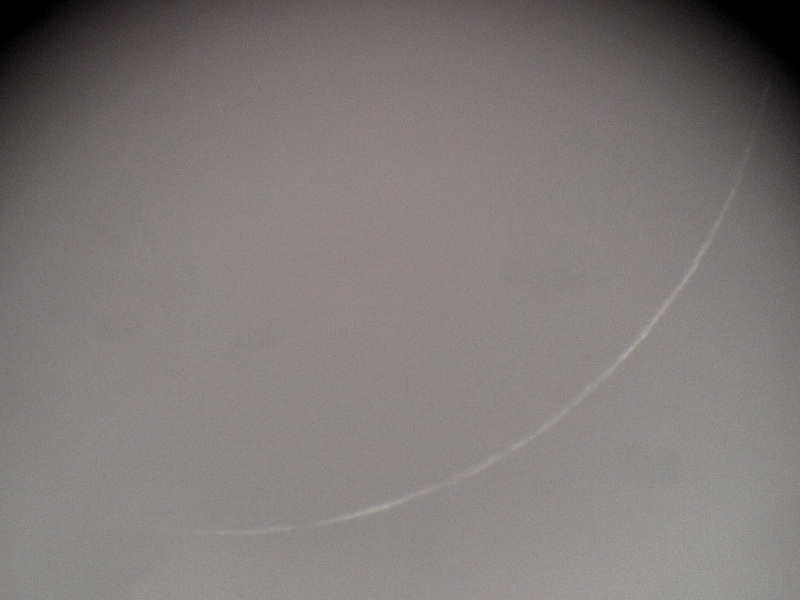
At 1824 MST, the moon was now an easy sight in the binoculars. This photo was taken with the D7000 DSLR at 182656 MST, f/5.6, 1/50sec, ISO 400, 300mm:
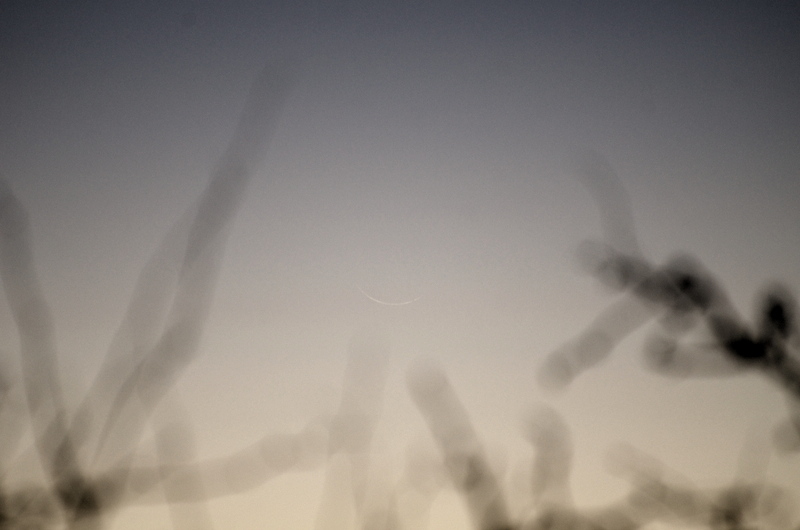
This iPhone afocal 77X image was captured at 182933 MST:
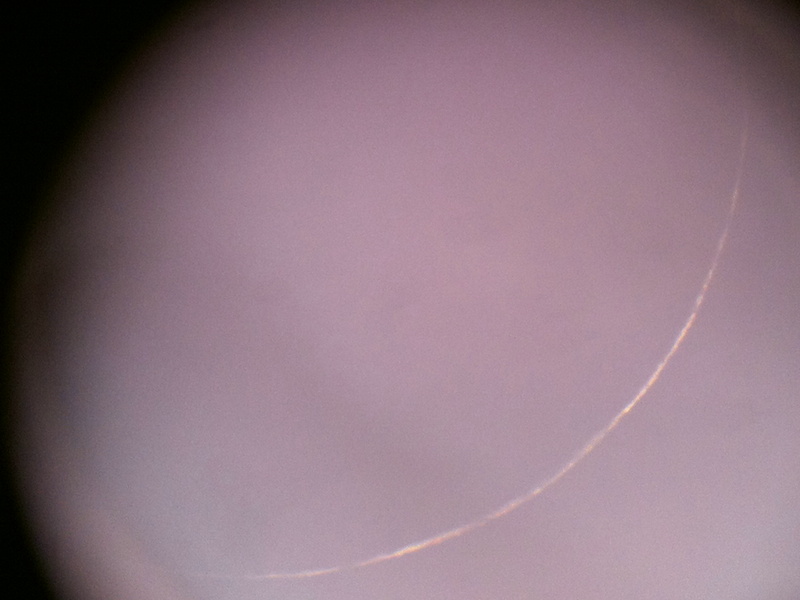
At 1831 MST, the moon was now into a tree as viewed from the observatory. I left the observatory to get a better view of the western sky (away from the low trees around the observatory). The moon was easily seen with the naked eye (if you knew where to look). I took this photograph at 183510 MST, D7000 DSLR, f/5.6, 1/25sec, ISO 800, 300mm:
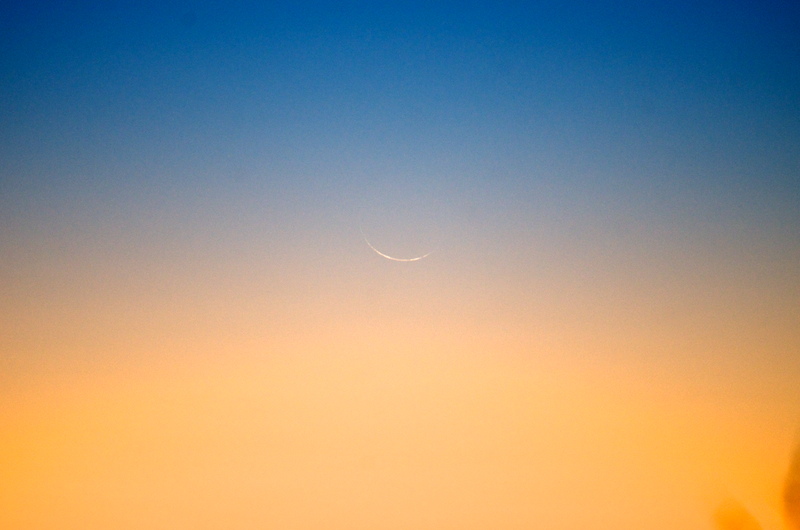
At 1847 MST, I took my last look at this very young moon, 77X, just prior to its setting. I then viewed Mercury, 77X.
Beginning at 1858 MST, I started preparing for the night's DSO imaging. I added the focal reducer to the 8" LX200-ACF and mounted the off-axis guider (OAG) on the D7000 DSLR camera body. At 1906 MST, I was ready for imaging and began waiting for twilight to end. My targets for this night would be IC342 (a faint but large galaxy) and NGC2359 (Thor's Helmet). I had imaged both of these on the previous session, but this night I would do 10 minute, ISO 6400, exposures (vs the 5 minute, ISO 6400, done before), and I would image using the focal reducer to make the telescope f/6.3 instead of f/10. I hoped to capture more details of each object.
At 1913 MST, I watched a low pass of the International Space Station (ISS). At 1916 MST, the Zodiacal Light was easily seen. It extended nearly to the Pleiades, which were at the zenith in my sky.
At 1925 MST, I slewed to IC342 and viewed the galaxy with the 26mm eyepiece + focal reducer. Some spiral structure was visible. I mounted the camera, did a focus test on the star Shedir with the Bahtinov Mask, and locked the telescope focus. I then slewed to IC342 and found a guide star in the illuminated reticle guiding eyepiece. At 1946 MST, I did a framing test exposure, followed by a 10 minute, ISO 6400, guided exposure. This is the resulting image, slightly cropped from the full-frame photo:
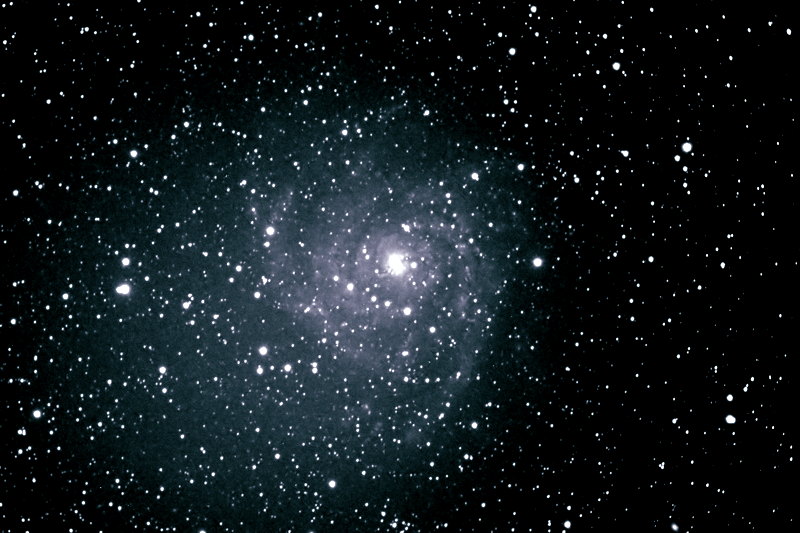
At 2005 MST, slewed to NGC2359, Thor's Helmet. I waited for it to rise higher in the sky but did find a good guide star. At 2025 MST, did a framing test exposure. This image, cropped from the full-frame photo, is a 10 minute, ISO 6400, guided exposure:
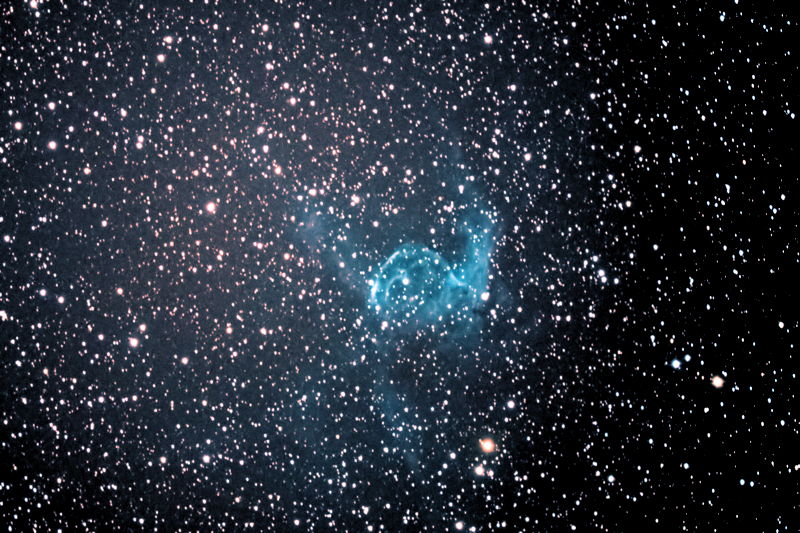
Thor's Helmet, with its "wings" and "chin strap" are easily seen in this image.
I ended imaging at 2038 MST. I viewed NGC2359 with the 26mm eyepiece + focal reducer. Considerable nebulosity was visible. The helmet and wings were seen. It was really a nice view.
I then viewed M42, the Great Nebula in Orion, 26mm eyepiece + focal reducer. That was a lovely wide-angle view.
Since I ran out of hot chocolate and the temperature was now 36°F, I decided to end this session.
The observatory was closed at 2115 MST, 36°F.
On Saturday, 9 February, William Keel (NGC3314) tweeted:
Comet ISON now showing tail, single 5m R-band exposure with @SARA_Obs 1m telescope at Kitt Peak. Feb 9.2 UT. http://t.co/MQ050rgc
I couldn't resist replying back to him. My tweet:
@NGC3314 @sara_obs I captured same Comet ISON tail with my @MeadeInstrument 8" LX200-ACF http://t.co/JIEbdFvW"
Click the links in the tweets to see the respective images. No need for a 1 meter telescope to image Comet ISON's tail! (But I wish I had one!! Of course, then I'd need a POD MAX!!!!)
Comments are welcome; use the Comments section below, or you can Email Me. Thanks.
Go to the previous report.
Return to the Cassiopeia Observatory Home Page.